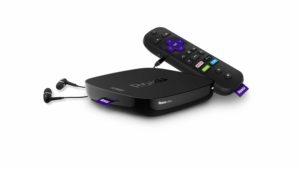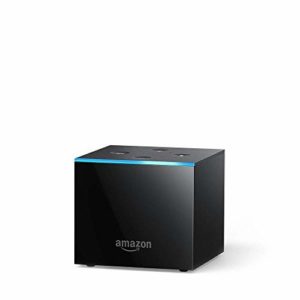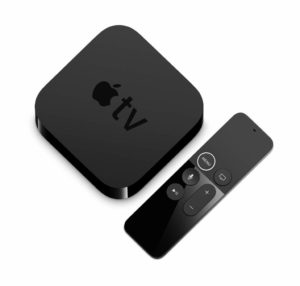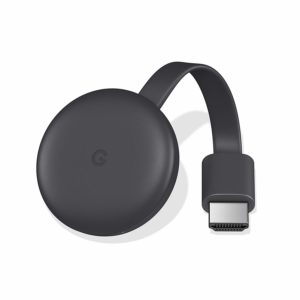First take
If you’re looking into cutting the cord for the first time or upgrading your streaming setup, choosing the right device for your needs doesn’t need to be difficult. In fact, we’ve already done the heavy research for you.
We’ve reviewed five of the top streaming TV devices on the market, as well as a few budget options, any of which could supplement or completely replace your cable package (when paired with the right livestreaming service, that is).
Best streaming device deals of 2019
Amazon will throw in a 90-day free trial of Amazon Music Unlimited with a new purchase of a Fire TV product.
Best streaming devices of 2019
- Roku Ultra—Best overall ($99)
- Amazon Fire TV Cube—Best for smart homes ($119.99)
- Apple TV 4K—Best for Apple fans ($179.99)
- NVIDIA Shield—Best for gamers ($188.48)
- Google Chromecast—Best for beginners ($35)
- Roku Streaming Stick—Best Roku budget option ($39.99)
- Amazon Fire TV Stick—Best Amazon budget option ($39.99)
Roku Ultra
Best overall
- $99
- 4K, HDR capability
- Ethernet and USB ports
Roku created the first streaming TV device for a little video startup called Netflix—that’s how long it’s been perfecting its black-and-purple boxes. Other streamers have come along since, but Roku is still among the best in our book; no other brand combines simplicity and performance like the original.
The Ultra is Roku’s most advanced streaming device, a flat 5-inch square that supports 4K and HDR resolution and sports an Ethernet port for a hardwired internet connection and a USB port for displaying outside media. There’s also a MicroSD slot for extra storage.
Roku Ultra pros and cons ![]()
- Clean, simple interface
- 4K and HDR capability
- Full-featured remote
- No Dolby Vision support
- Limited voice command
- Overwhelming app store
All that’s useful, but the Ultra’s remote is the real star of the package. It’s only the size of a Snickers bar, but it handles every function you’ll ever need even without voice command (which it also does, passably). It also has four preset shortcut buttons for select streaming services (like Netflix and Sling TV), as well as two buttons that can be programmed to personalized shortcuts.
The Ultra remote can also be set to control your TV’s power and volume, but its coolest feature is easily the headphone jack (JBL earbuds included) for private listening. Your roommates will hear only you yelling at Thursday Night Football.
There are nearly 2,000 streaming apps available in Roku’s Channel Store, the strongest selling point of any Roku model. You’ll never use most of them—there are a lot of third-party beta oddities for niche interests—but all of the major streaming players are represented.
Amazon Fire TV Cube
Best for smart homes
- $119.99
- 4K, HDR capability
- Built-in Alexa voice control
Before the Fire TV Cube came along, we had reservations about Amazon streaming devices. They worked well but tended to throw Amazon content and products in your face regardless of what you were searching for—sponsored content taken to the smiley-face extreme.
Fortunately, Fire TV Cube doesn’t play like that. The Cube is not only refreshingly brand-neutral in its searches and recommendations but also the first Fire TV device to feature built-in Alexa voice control. And on top of that, it can be programmed to act as command central for your entire media center.
Amazon Fire TV Cube pros and cons ![]()
- 4K, HDR capability
- Alexa voice control
- Home and media center integration
- Limited remote
- No dedicated Ethernet or USB ports
- Larger size
As a streaming TV device—lest we forget its intended function—the Fire TV Cube also wows. Thanks to a hexa-core processor, it’s fast, responsive, and supports 4K Ultra HD in addition to HDR, HDR 10, HDR 10+, HLG, Dolby Vision, as well as basic 1080p HD.
In contrast, the Fire TV Cube’s included remote is nothing extravagant. It’s a slick-but-standard clicker with no shortcuts or extra features. With all of this Alexa control, Amazon probably assumes you’ll never even take it out of the wrapper (and we doubt they’re wrong).
The Fire TV Cube doesn’t come with a standard-sized USB port (just Micro USB) or an Ethernet port (though it does come with an adapter for wired internet), which seem like weird exclusions considering the size of the device. With so much available real estate, why skimp on ports?
Minor quibbles aside, the Fire TV Cube has everything that tech perfectionists could want in a streaming TV device, like full entertainment-center command capabilities and seamless Alexa integration. Even better, all apps are treated equally to Prime Video.
That’s plenty of incentive to spend just $20 over a Roku Ultra—if you’re a voice-control buff who wants the complete Skynet experience. But, if you’re just looking for a basic streamer to binge Terminator flicks on, the Cube might be more than you need.
NVIDIA Shield
Best for gamers
- $188.48
- 4K, HDR capability
- Full gaming features
All of the devices we’ve talked about so far are TV streamers that feature a wee bit of gaming functionality. But if you’re a gamer who’d also like to stream TV without piling up devices, the NVIDIA Shield can handle both with no compromises.
The Shield is based on the Android platform and runs apps from the Google Play store—meaning the selection is yuge with a “Y.” It’s also almost as expensive as the Apple TV 4K, so consider just how serious you are about splitting your gaming and TV time.
NVIDIA Shield pros and cons ![]()
- Powerful, fast processor
- Large app selection
- High price tag
- Limited remote
The NVIDIA Shield has 4K and HDR video capability, as well as Dolby Atmos and DTS-X surround sound. It’s also fast and powerful (because it’s a gaming console) and will work with either Google Assistant or Amazon Alexa/Echo for hands-free, whole-home control.
And that’s a good thing because the Shield’s remote is the definition of “bare-bones,” with just a circular navigation/Select, Home, Back, and mic buttons, and a touch-surface volume control that also works as a Play/Pause button when double-tapped. The Shield gears toward voice command, for sure.
Overall, the NVIDIA Shield is a killer gaming console that streams TV legit well. If you’re a power-gamer who also watches TV, 1. congratulations on mastering time management, and 2. this is obviously the streaming TV device for you. Non-gamers, maybe move along.
Apple TV 4K
Best for Apple fans
- $179.99
- 4K, HDR capability
- Siri voice command
People don’t merely like Apple—they live it. This might seem cult-y to outsiders who pay no mind to brands, but the appeal is real: Apple products work fantastically, and they work even more fantastically with other Apple products. Anyone who’s ever tried to sync up a Samsung gadget with an LG device can appreciate that.
If you’re already an Apple devotee, the Apple TV 4K is your streaming device. It costs more than most others, but that’s rarely a deterrent for the faithful. The Apple-curious, on the other hand, might need some convincing.
Apple TV 4K pros and cons ![]()
- Seamless Apple integration
- Excellent picture and audio
- Fast and responsive interface
- High cost
- Limited app selection
- Limited remote
In the plus column, the Apple TV 4K is furiously fast, thanks to its A10X Fusion chip that standard quad-cores can’t touch. It also supports 4K, HDR, Dolby Vision, and HDR10 video, and Dolby Digital Plus 7.1 surround sound. As you’d expect from Apple, the interface is pristine and sleek—even the most advanced devices from other brands still somehow look clunky in comparison.
The included Siri remote is deceptively minimal, featuring just Menu, TV, Play/Pause, a volume rocker, and a mic button—oh, and a touch surface that functions as a tiny mouse pad. If you’re used to a more button-populated remote, it can be baffling at first, but it works. Of course, it works even better using Siri voice command (which is probably the point).
Then again, some people still prefer pushing buttons. If you’re not on speaking terms with Siri, you can also control your entire Apple entertainment system (and house, with HomeKit) with your iPhone or iPad. If Phil can do it on Modern Family, so can you.
It may not have as many apps available on iTunes as Roku’s Channel Store (who does?), but Apple TV 4K is still an impressive streaming device that even those outside of the Apple bubble might want to check out. (Apple heads, we know you already have at least one.)
Google Chromecast
Best for beginners
Google Chromecast is a streaming device in only the loosest sense: it’s an HDMI stick that “casts” content from your phone, tablet, or laptop to a TV. The Ultra model can do 4K, but Chromecast features no interface or content of its own—it’s basically a mirror of other devices.
That’s great if you’re a regular mobile viewer who’d like to watch movies or shows on a TV occasionally (or maybe your phone screen is cracked—we’ve all been there).
Google Chromecast pros and cons ![]()
- Cheap price
- Simple setup
- Glitchy performance
- Limited app selection
But really, the biggest selling points of Google Chromecast is that it’s cheaper than most straight-up streaming boxes, and it’s simple to set up. If you can pull up something to watch on your phone and locate an HDMI port on your TV, you’re in business.
On the other hand, Chromecast, which hasn’t been updated significantly in years, can be glitchy and laggy due to its limited Wi-Fi capabilities. Fortunately, the 4K-ready Ultra model mostly remedies this problem with an Ethernet adapter port for a hardwired internet connection. The Ultra is also twice the price, though.
For $35, the Google Chromecast is more of a cool toy than a serious streaming device; even the more-advanced Ultra has been surpassed by other brands in higher performance at lower prices. Both models are now also five years old—which is more like 50 in tech years.
More top streaming devices
Fortunately, if you’re looking for something smaller and cheaper than a set-top box, Google Chromecast isn’t your only option. Here are a couple of streaming TV sticks that cost under $50 while still coming this close to matching the performance of their bigger-box brothers.
Roku Streaming Stick
Best Roku budget option
The Roku Streaming Stick is essentially the Ultra shrunk to thumb-drive size, minus the Ethernet and USB ports and the 4K capability (but the Roku Streaming Stick+ can do 4K for $20 more).
For $39.98, the Roku Streaming Stick gives you the Ultra’s dual-band wireless Wi-Fi performance, voice remote (without the headphone jack), and full Roku functionality at less than half the price (and size). It also works with Google Assistant and Amazon Alexa/Echo.
Roku Streaming Stick pros and cons ![]()
- Low price
- Full Roku experience
- No Ethernet or USB ports
- No 4K (basic model)
Amazon Fire TV Stick
Best Amazon budget option
- $39.99
- 4K, HDR capability
- Alexa voice remote
As with Roku’s stick model, the Fire TV Stick does almost everything that Amazon’s larger version does (including 4K, for the $10-more Fire TV Stick 4K). It can even be set up for wired internet with a sold-separately Ethernet adapter, and it still takes up only a fraction of the space that the Cube does.
There are, however, two major differences between the Stick and the Cube: the Cube’s processor is still faster, and the Stick is stuck in Amazon’s old interface ways of pushing Prime programming and products.
Amazon Fire TV Stick pros and cons ![]()
- Inexpensive price
- Ethernet capability
- No 4K (basic model)
- Amazon-heavy content promotion
What to look for in a streaming device
Interfaces vary between brands, but some features are universal (if not always necessary). Here are a few details to check for when shopping for a streaming device.
Ethernet and USB ports
All current streaming devices are designed to work with Wi-Fi, but there’s still no substitute for directly-connected internet with an Ethernet cable. Most set-top boxes include an Ethernet port; with exceptions like the adaptable Fire TV Stick, sticks are strictly Wi-Fi.
USB ports for connecting outside media (like MP4s, MP3s, photos, etc.) on thumb drives or other sources are handy to have. Most set-top boxes include one but some, like the NVIDIA Shield, feature two.
Dual-band antenna Wi-Fi
If an Ethernet connection isn’t an option, or if you’d rather not add to the nest of cables behind your TV, the quality of your device’s Wi-Fi receiver matters. Yes, even if it’s sitting right next to the router (hence that nest of cables).
All of the devices reviewed here feature dual-band antennas, meaning they can receive Wi-Fi signals at 5 GHz or 2.4 GHz, or they can receive both simultaneously. TL;DR: the devices we’ve highlighted can have more data delivered faster over longer ranges, which is a good thing. Some less-expensive Roku streaming devices, like the Premiere and Express models, use single-band antennas.
Available apps
All of the big streaming players, like Netflix and Hulu, can be found in each device’s respective app stores—but not every app is available for every device. What if you can’t get The Yachting Channel on your shiny new streamer?
Roku has the largest library (including, yes, The Yachting Channel), while the others have a few app gaps (you can’t get Vudu on Amazon Fire TV or Apple TV devices, for example). Before you go all-in on a device, you might want to check its app store first.
Final cut
There’s little qualitative difference between our top three device picks—Roku Ultra, Amazon Fire TV Cube, and Apple TV 4K are all excellent streamers. Regardless of your tastes or budget, none of them would disappoint (unless, again, you can’t live without The Yachting Channel).
Overall, we like the Roku Ultra for its sheer simplicity and universal appeal: it’s easy for first-time streamers to begin using, advanced enough to keep old pros engaged, and it doesn’t discriminate when it comes to content.
The Cube is a vast improvement over previous Fire TV devices, especially when it comes to leveling the playing field for non-Amazon entertainment (though it’s still optimal for Prime Video). If you’re an Amazon aficionado who wants to run your household through Alexa, go for the Cube.
And Apple people—you know who you are—Apple TV 4K is your streamer.
Streaming devices FAQ
Do I need a streaming device if I already have a smart TV?
Smart TVs come equipped with plenty of usable apps, but we recommend a separate streaming device. You’ll have access to a lot more content, and the performance will be less glitchy.
Is there a monthly fee to use streaming devices and apps?
Unlike cable and satellite boxes, there’s no monthly rental charge associated with streaming devices—once you buy it, it’s yours.
Apps like Netflix, Hulu, and HBO NOW require monthly subscription fees, but the majority of available streaming apps are ad-supported freebies (especially in Roku’s overflowing Channel Store). Apps like Pluto TV and Tubi offer a giant selection of free TV shows and movies, with fewer ads than those found on commercial TV.
Do I need to be an Amazon Prime member to use the Fire TV Cube?
You don’t have to be an Amazon Prime member to stream with the Fire TV Cube—but you’ll be missing out if you’re not. The Cube is Amazon’s most brand-neutral device yet, but all Fire TV streamers are still designed to deliver the perfect Prime Video experience first.









